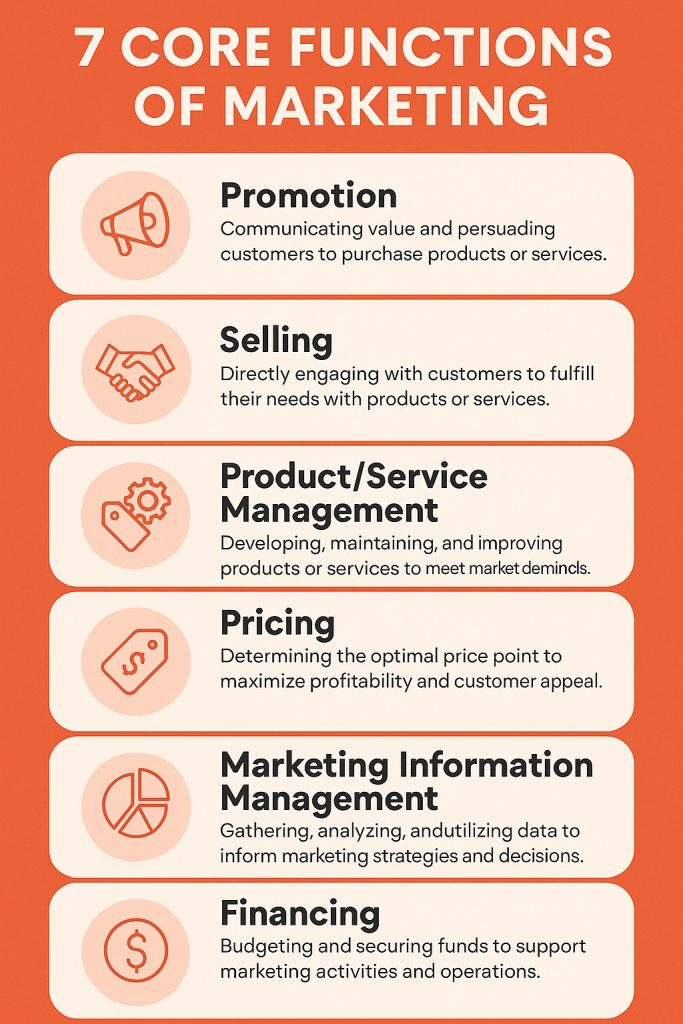Marketing isn’t just about catchy ads or viral social posts — it’s the backbone of how businesses grow, compete, and survive. Every product that reaches a customer, every price tag that drives profit, every story that makes a brand memorable rests on a set of 7 functions of marketing.
These functions are more than theory; they are the daily playbook of successful companies. They shape how Netflix evolves its content library, how Apple sets premium pricing, and how Amazon perfects its distribution. When executed well, they can launch a startup into the spotlight or breathe life into a struggling brand.
7 Functions of Marketing are:

- Promotion
- Selling
- Product/Service Management
- Pricing
- Marketing Information Management
- Financing
- Distribution (Channel Management)
Note: Some curricula swap Financing for Market Planning, but the foundational principles remain aligned.
In the pages ahead, we’ll unpack each of these functions not as textbook definitions, but as strategic levers you can use to grow in today’s hyper-competitive, tech-driven economy.
1. Promotion
Promotion is about communicating value to your target audience. It involves advertising, content marketing, PR, influencer campaigns, and more. The goal is to create awareness, build interest, and drive action. In modern digital campaigns, many marketers adopt cost per mille (CPM) models to budget and scale their ad impressions — you can read in detail how CPM works and when to use it in our article on Cost Per Mille Advertising. In 2025, promotion increasingly relies on personalized content, AI-driven ad targeting, and storytelling across multiple platforms—from TikTok to LinkedIn.
Do you know? Leveraging influencer marketing is a rising tactic—brands that find micro influencers can reach niche audiences with high authenticity.
2. Selling
Selling is the process of turning prospects into paying customers by aligning products with needs. It’s more than pushing a transaction—it’s about understanding pain points, offering tailored solutions, and creating positive experiences. In 2025, selling involves consultative approaches, social selling on platforms like LinkedIn, and seamless e-commerce experiences. Whether B2B or B2C, modern selling combines human connection with automation, chatbots, and CRM data. Sales success depends on trust-building, objection handling, and customer-centric approaches. A strong selling function drives revenue, increases customer lifetime value (CLV), and builds brand advocates who continue to fuel growth.
For small businesses, relationship-building and visibility can be boosted with affordable PR strategies
3. Product/Service Management
Product/service management ensures offerings meet customer needs and stay competitive. This function spans ideation, development, iteration, and lifecycle optimization. In 2025, SaaS businesses run rapid A/B tests, e-commerce brands monitor consumer feedback in real-time, and B2B firms align roadmaps with industry shifts. Effective management integrates customer insights, competitor analysis, and innovation. The function’s success ensures that products evolve with markets instead of becoming obsolete. Businesses that excel here build loyalty and resilience, adapting offerings to trends like sustainability, personalization, or AI-driven features. It’s the backbone of long-term growth and differentiation.
4. Pricing
Pricing defines how much value customers are willing to exchange for a product or service. It’s not just numbers—it’s psychology, strategy, and positioning. In 2025, dynamic pricing, subscription models, and value-based pricing dominate. E-commerce brands adjust prices in real time using AI, while B2B companies justify premium pricing with consultative selling. Poor pricing erodes trust or profitability, while smart pricing drives revenue, market share, and loyalty. It balances competitiveness with perceived value, ensuring sustainable margins while delivering affordability. The pricing function requires deep market research, elasticity analysis, and constant optimization to stay aligned with consumer expectations and economic conditions.
5. Marketing Information Management
Marketing Information Management (MIM) is the systematic collection, analysis, and use of customer and market data. In 2025, data-driven decisions are non-negotiable—whether via AI analytics, heatmaps, or predictive modeling. MIM ensures strategies are based on facts, not assumptions. This function integrates surveys, CRM insights, social listening, and competitive intelligence to identify trends and opportunities. Businesses that leverage strong MIM can spot shifting behaviors early and act faster than competitors. Mismanaging information, however, leads to wasted spend and irrelevant campaigns. Done right, MIM enables precision targeting, optimized messaging, and higher ROI across all other marketing functions. Remember, data-driven insights power not only campaigns but also long-term planning, as discussed in my guide to future digital marketing strategies.
6. Financing
Financing ensures that marketing activities and product delivery have the financial backing to succeed. It covers budgeting, securing funding, allocating resources, and measuring return on investment (ROI). In 2025, financing also includes leveraging MarTech investments, sustainable budgeting, and accessing creative funding models like crowdfunding or venture partnerships. Without financial discipline, even the best marketing strategies collapse under overspending or lack of resources. Financing aligns marketing goals with business realities, ensuring profitability and scalability. It’s often overlooked but critical in supporting promotion, product development, and channel expansion.
7. Distribution (Channel Management)
Distribution, or channel management, ensures products and services reach customers efficiently. This includes logistics, retail placement, e-commerce fulfillment, partnerships, and omnichannel strategies. In 2025, businesses are investing heavily in last-mile delivery, digital marketplaces, and hybrid models that blend physical and online presence. Effective distribution optimizes reach, convenience, and customer experience. Poor distribution leads to delays, stockouts, or lost trust. Strong channel management balances cost-efficiency with customer satisfaction, ensuring products are available when and where they’re needed—whether through Amazon, direct-to-consumer platforms, or local retail partnerships.
How the 7 Functions Work Together?
The seven core functions of marketing are not stand-alone activities; they operate as an interconnected system that powers sustainable business growth. Think of them as a flywheel of marketing: insights gathered through Marketing Information Management (MIM) guide product or service development. Strong Product/Service Management then informs smart Pricing strategies, which must be supported by realistic Financing decisions. Once in place, these offerings are amplified through Promotion, reaching audiences across multiple platforms. Distribution (Channel Management) ensures customers can access products conveniently, while Selling closes the loop by converting interest into revenue and feedback.
Each function reinforces the others, creating a cycle of continuous improvement. For example, sales data feeds back into product innovation, while promotional outcomes inform pricing adjustments. When aligned, these functions become more than operational steps—they form a self-sustaining system that drives efficiency, maximizes ROI, and builds long-term customer loyalty.
Financing vs Market Planning
In marketing education, some frameworks replace Financing with Market Planning as the seventh core function. Financing focuses on budgets, funding, and resource allocation—ensuring campaigns, product launches, and distribution have the financial support to succeed. Market Planning, on the other hand, emphasizes research, segmentation, and aligning strategies with customer and market needs. Both are critical in 2025: financing guarantees sustainability and profitability, while market planning ensures relevance and adaptability in competitive environments. Whether businesses prioritize funding or strategy alignment, integrating both perspectives creates a stronger, data-driven marketing foundation that balances creativity with financial discipline.
Comparison: 7 Functions vs 4Ps vs 7Ps
| Framework | Elements | Focus |
|---|---|---|
| 7 Functions | Promotion, Selling, Product Mgmt, Pricing, MIM, Financing, Distribution | Operational backbone |
| 4Ps | Product, Price, Place, Promotion | Tactical mix |
| 7Ps | Product, Price, Place, Promotion, People, Process, Physical Evidence | Service/experience marketing |
People Also Ask (PAA) FAQs
- What are the 7 core functions of marketing?
They are Promotion, Selling, Product/Service Management, Pricing, Marketing Information Management, Financing, and Distribution. - Why are the 7 functions of marketing important?
They provide a framework for aligning business goals with customer needs and market trends. - Which function is most important?
All are interdependent, but Marketing Information Management drives data-based decisions. - What is the difference between 7 functions and 4Ps?
The 7 functions focus on execution, while the 4Ps define the mix. - How do businesses measure success in promotion?
KPIs like CTR, CPL, ROI, and engagement rate are common. - Is financing really part of marketing?
Yes, as it ensures campaigns and strategies have the resources to succeed. - What happens if pricing is wrong?
It can damage profitability, trust, and competitiveness. - Why is distribution crucial in 2025?
Because customer expectations for fast, reliable delivery are higher than ever. - Can AI improve marketing functions?
Absolutely—AI enhances data analysis, personalization, pricing, and promotion. - Do small businesses need all 7 functions?
Yes, though scaled to budget—they’re essential for structured growth.
The Strategic Impact of the 7 Functions of Marketing
Before wrapping up, it’s essential to highlight the strategic impact of the 7 functions of marketing on modern businesses. These functions don’t just support operations—they shape brand perception, customer loyalty, and long-term competitiveness. By aligning promotion, selling, pricing, and distribution with reliable market research and financing, businesses create a roadmap that balances creativity with profitability. In today’s data-driven economy, organizations that leverage these functions gain measurable advantages: higher ROI, faster adaptability, and stronger customer relationships.
For startups, mastering these functions accelerates growth on lean budgets. For enterprises, they ensure scalability and sustainable positioning in global markets. Whether through AI-powered insights, influencer partnerships, or omnichannel distribution, the seven functions act as the foundation of every successful marketing strategy in 2025 and beyond.
Bottom Line: The Backbone of Every Successful Business
The 7 core functions of marketing—Promotion, Selling, Product/Service Management, Pricing, Marketing Information Management, Financing, and Distribution—form the backbone of every successful business strategy. They are not isolated silos but interconnected gears in a flywheel, each reinforcing the others to drive sustainable growth.
In 2025 and beyond, success belongs to businesses that embrace agility, data-driven decision-making, and customer-centric strategies. Whether you’re a startup founder, marketing student, or corporate strategist, mastering these functions helps you cut through digital noise, earn customer trust, and scale with confidence.
Think of them as your marketing operating system: when properly aligned, they transform challenges into opportunities, and ideas into measurable impact.
So, the question isn’t whether your business needs these functions—it’s how well you integrate them into a seamless, forward-looking strategy. Done right, they don’t just fuel growth; they future-proof your brand in an ever-changing market.


